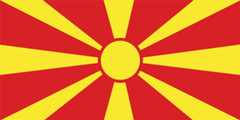Our editors will review what you’ve submitted and determine whether to revise the article.
Cultural life
Great effort has been invested in the support ofMacedonian language andculture, not only througheducation but also through theatre and other arts as well as the media ofmass communication.
News•
Daily life and social customs
As a result of the long presence of the Ottoman Turks in the region, the traditionalcuisine of North Macedonia is not only based on Balkan and Mediterranean fare but also flavoured by Turkish influences. Among thecountry’s dishes of Turkish origin arekebapcinja (grilledbeef kebabs) and theburek, a flaky pastry often stuffed withcheese,meat, orspinach. Macedonians also enjoy other foods that are common throughout theBalkans, includingtaratur (yogurt with shreddedcucumber) andbaklava. Macedonian specialties includeajvar (a sauce made from sweet red peppers),tavce gravce(baked beans),shopska salata (asaladcombining sliced cucumbers,onions, andtomatoes with soft white cheese), andselsko meso(pork chops andmushrooms in brown gravy).
In addition to Orthodox Christian and Islamic religious holidays, a number of holidays tied to the country’s history are celebrated in North Macedonia, including Independence Day (September 8), marking the day in 1991 when Macedonians voted for independence from federatedYugoslavia.
The arts
Despite the refusal of Macedonia’s Serbian rulers to recognize Macedonian as a language, progress was made toward the foundation of a national language andliterature in the early 20th century, especially by Krste P. Misirkov in hisZa Makedonskite raboti(1903; “In Favour of Macedonian Literary Works”) and in the literary periodicalVardar (established 1905). These efforts were continued during the interval betweenWorld War I andWorld War II, most notably by the poet Kosta Racin. After World War II, Macedonia—freed to write and publish in its own language—produced such literary figures as poets Aco Šopov,Slavko Janevski, Blae Koneski, and Gane Todorovski. Janevski also authored the first Macedonian novel,Selo zad sedumte jaseni (1952; “The Village Beyond the Seven Ash Trees”), and a cycle of six novels dealing with Macedonian history. After World War II, Macedonian theatre was invigorated by a wave of new dramatists that included Kole Čašule, Tome Arsovski, and Goran Stefanovski. Among the best-known fiction writers of prose are Živko Čingo, Vlada Urošević, and Jovan Pavlovski. (SeeMacedonian literature).
The popular culture of North Macedonia is a fascinating blend of local tradition and imported influence.Folk music andfolk dancing are still popular, androck andpop music areubiquitous.Icon painting and wood carving both have long histories in North Macedonia.Motion picture making in North Macedonia dates to the early 20th-century efforts of brothers Milton and Janaki Manaki and includesBefore the Rain (1994), which was directed by Milcho Manchevski and was nominated for anAcademy Award for best foreign-language film.
Cultural institutions
Located inOhrid, the National Museum features an archaeological collection dating from prehistoric times. Ohrid itself is one of the oldest human settlements inEurope, and the natural and cultural heritage of the Ohrid region was designated as a UNESCOWorld Heritage site in 1980. Also of note are theMuseum of Contemporary Art inSkopje and the Museum of the City of Skopje.
Throughout the country, annual festivals are held, including the Skopje Jazz Festival, the Balkan Festival of Folk Songs and Dances in Ohrid, the Ohrid Summer Festival, and the pre-Lenten Carnival in Strumica. An internationalpoetry festival is held annually in the lakeside resort of Struga.
Sports and recreation
A modern sports culture was slow to develop in North Macedonia. In the post-World War II era,football (soccer) emerged as a popular sport, encouraged, along withbasketball andvolleyball, by the larger industrial firms, which often fielded their own teams. In the late 20th and early 21st centuries,tennis began to grow in popularity in the larger urban centres. The1996 Olympic Games in Atlanta,Georgia, U.S., marked the first Games at which Macedonia was represented as an independent state.
During the 1970s, winter sports gained considerably in popularity in North Macedonia, as the country’s mountainous terrainfacilitated the creation of several ski resorts, especially in theŠar Mountains, and near Mavrovo and Krushevo. There are also activemountaineering societies, maintaining huts in the Babuna massif south of Skopje, in the Šar Mountains, and on Baba Mountain. Macedonians generally seem to prefer to take their fresh air and exercise in the form of mountaineering andhunting. On the other hand,chess has a wide and enthusiastic following in the country.
Media and publishing
TheMacedonian Information Agency (MIA), which provides news and public information, was originally chartered by the parliament in 1992 but did not begin operation until 1998. In 2006 the government transformed the MIA frompublic enterprise tojoint-stock company. Founded in 1992, Makfax was the region’s first privatenews agency. Although private competitors exist, the major provider of radio and television service is the government-operated Macedonia Radio Television, which began life as Radio Skopje in 1944.













